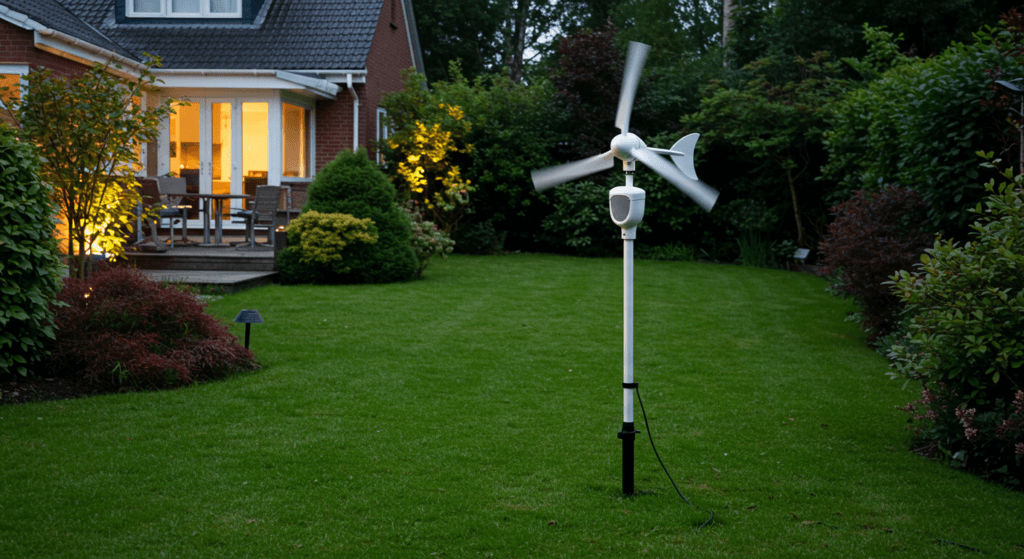Class H – Wind turbine on a domestic property
The permitted development right of Class H allows you to install, alter or replace a wind turbine on a residential property without planning permission. This can be a house, bungalow or a block of flats. You are permitted to install it either on the property itself or on a property within the curtilage.
For a stand-alone wind turbine on a residential property see Class I.

What are the limits for the wind turbine?
The wind turbine must comply with the Microgeneration Certification Scheme (MCS) or equivalent. You are limited to one wind turbine on the property and would need full planning permission if you already had an air source heat pump.
The wind turbine cannot exceed the roof height (excluding the chimney) by more than 3m, or 15m maximum which ever is the lower. It must however have at least 5m between any blade and the ground. The wind turbine must not be within 5m of a boundary, which probably limits these to detached dwellings or blocks of flats.
You can’t install a wind turbine on a listed building, scheduled monument, AONB, The Broads etc., but can be erected in a conservation area as long as it is not erected on a wall or roof slope facing a highway.
The full legislation for wind turbines can be found below.
Legislation
Class H – installation or alteration etc of wind turbine on domestic premises
Permitted Development
H. The installation, alteration or replacement of a microgeneration wind turbine on—
(a) a detached dwellinghouse; or
(b) a detached building situated within the curtilage of a dwellinghouse or a block of flats.
Development not permitted
H.1 Development is not permitted by Class H unless the wind turbine complies with the MCS Planning Standards or equivalent standards.
H.2 Development is not permitted by Class H if—
(a) in the case of the installation of a wind turbine the development would result in the presence of more than 1 wind turbine on the same building or within the curtilage;
(b) in the case of the installation of a wind turbine, a stand-alone wind turbine is installed within the curtilage of the dwellinghouse or the block of flats;
(c) in the case of the installation of a wind turbine, an air source heat pump is installed on the same building or within its curtilage;
(d) the highest part of the wind turbine (including blades) would either—
(i) protrude more than 3 metres above the highest part of the roof (excluding the chimney); or
(ii) exceed more than 15 metres in height,
whichever is the lesser;
(e) the distance between ground level and the lowest part of any blade of the wind turbine would be less than 5 metres;
(f) any part of the wind turbine (including blades) would be positioned so that it would be within 5 metres of any boundary of the curtilage of the dwellinghouse or the block of flats;
(g) the swept area of any blade of the wind turbine would exceed 3.8 square metres;
(h) the wind turbine would be installed on safeguarded land;
(i) the wind turbine would be installed on a site designated as a scheduled monument;
(j) the wind turbine would be installed within the curtilage of a building which is a listed building;
(k) in the case of land within a conservation area, the wind turbine would be installed on a wall or roof slope of—
(i) the detached dwellinghouse; or
(ii) a building within the curtilage of the dwellinghouse or block of flats,
which fronts a highway; or
(l) the wind turbine would be installed on article 2(3) land other than land within a conservation area.
Conditions
H.3 Development is permitted by Class H subject to the following conditions—
(a) the blades of the wind turbine is made of non-reflective materials;
(b) the wind turbine is, so far as practicable, sited so as to minimise its effect on the external appearance of the building;
(c) the wind turbine is, so far as practicable, sited so as to minimise its effect on the amenity of the area; and
(d) the wind turbine is removed as soon as reasonably practicable when no longer needed.
Wind turbines Page Updated: 3rd February 2025



